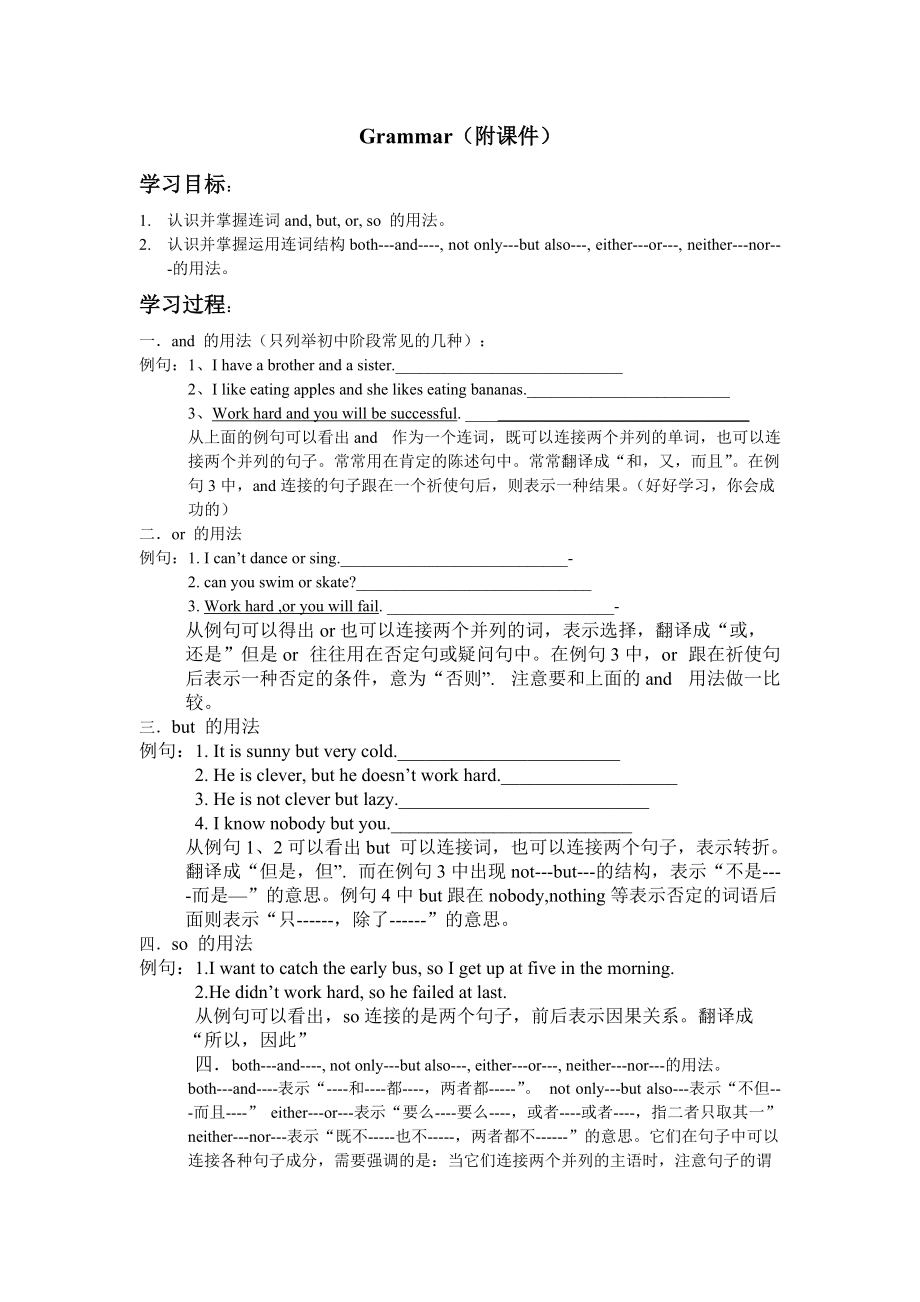《【2014年秋】九年級(jí)英語(yǔ)上冊(cè)(牛津譯林版)《Unit1Knowyourself》導(dǎo)學(xué)案4》由會(huì)員分享����,可在線閱讀����,更多相關(guān)《【2014年秋】九年級(jí)英語(yǔ)上冊(cè)(牛津譯林版)《Unit1Knowyourself》導(dǎo)學(xué)案4(2頁(yè)珍藏版)》請(qǐng)?jiān)谘b配圖網(wǎng)上搜索�����。
1�����、Grammar(附課件)
學(xué)習(xí)目標(biāo):
1. 認(rèn)識(shí)并掌握連詞and, but, or, so 的用法��。
2. 認(rèn)識(shí)并掌握運(yùn)用連詞結(jié)構(gòu)both---and----, not only---but also---, either---or---, neither---nor---的用法���。
學(xué)習(xí)過(guò)程:
一.a(chǎn)nd 的用法(只列舉初中階段常見的幾種):
例句:1�、I have a brother and a sister.____________________________
2���、I like eating apples and she likes eating banan
2���、as._________________________
3、Work hard and you will be successful. ___________________________________
從上面的例句可以看出and 作為一個(gè)連詞��,既可以連接兩個(gè)并列的單詞,也可以連接兩個(gè)并列的句子��。常常用在肯定的陳述句中��。常常翻譯成“和�,又,而且”����。在例句3中,and連接的句子跟在一個(gè)祈使句后���,則表示一種結(jié)果��。(好好學(xué)習(xí)���,你會(huì)成功的)
二.or 的用法
例句:1. I can’t dance or sing.____________________________-
3、 2. can you swim or skate?_____________________________
3. Work hard ,or you will fail. ____________________________-
從例句可以得出or也可以連接兩個(gè)并列的詞���,表示選擇,翻譯成“或�����,還是”但是or 往往用在否定句或疑問(wèn)句中。在例句3中�,or 跟在祈使句后表示一種否定的條件,意為“否則”. 注意要和上面的and 用法做一比較�。
三.but 的用法
例句:1. It is sunny but very cold.____________________
4、____
2. He is clever, but he doesn’t work hard.___________________
3. He is not clever but lazy.___________________________
4. I know nobody but you.__________________________
從例句1�����、2可以看出but 可以連接詞����,也可以連接兩個(gè)句子,表示轉(zhuǎn)折�。翻譯成“但是,但”. 而在例句3中出現(xiàn)not---but---的結(jié)構(gòu)�,表示“不是----而是—”的意思。例句4中but跟在nobody
5�、,nothing等表示否定的詞語(yǔ)后面則表示“只------,除了------”的意思���。
四.so 的用法
例句:1.I want to catch the early bus, so I get up at five in the morning.
2.He didn’t work hard, so he failed at last.
從例句可以看出��,so連接的是兩個(gè)句子�����,前后表示因果關(guān)系���。翻譯成“所以����,因此”
四.both---and----, not only---but also---, either---or---, neither---nor---的用法��。
6����、both---and----表示“----和----都----,兩者都-----”���。 not only---but also---表示“不但---而且----” either---or---表示“要么----要么----����,或者----或者----��,指二者只取其一” neither---nor---表示“既不-----也不-----���,兩者都不------”的意思。它們?cè)诰渥又锌梢赃B接各種句子成分�����,需要強(qiáng)調(diào)的是:當(dāng)它們連接兩個(gè)并列的主語(yǔ)時(shí),注意句子的謂語(yǔ)動(dòng)詞形式��。
例句:
1. Both he and she are from England.
2. Not only he but also
7����、 his brother likes swimming.
3. Either Lily or her classmates are ready to help Tom..
4. Neither you nor he knows the way to the post office.
從以上例句可以看出,both---and----連接并列主語(yǔ)時(shí)��,謂語(yǔ)動(dòng)詞用_________(單/復(fù))數(shù)形式���。而用not only---but also---, either---or---, neither---nor---連接并列主語(yǔ)時(shí)�����,謂語(yǔ)動(dòng)詞的形式要和最接近的主語(yǔ)要保持一致�。
同學(xué)們�,看完上面的簡(jiǎn)單
8、介紹����,請(qǐng)你們完成下面的任務(wù):
1. 在P12頁(yè)下方,試著用and, but, or, so來(lái)連接句子���,并且翻譯句子�。
2. 完成P14頁(yè)的兩個(gè)練習(xí),當(dāng)堂給出答案�����。
達(dá)標(biāo)檢測(cè):
1. Mr. Smith is an English teacher ______ he teaches us English well.
A. or B. and C. but D. so
2. — Would you like to go to the concert with me tonight?
— I’d love to, ______ I can’
9���、t. I have a lot of homework to do.
A. or B. and C. but D. so
3. When you are learning English, use it as often as possible, _____ you will fail..
A. or B. and C. but D. so
4. Do you like to have Chinese food ______ western food?
A. or B. and
10�����、 C. but D. so
5. Not only my father but also my grandparents_______watching TV.
A. like B. likes C. to like D. have
6. Neither Jim nor his classmates _______to school on Sundays.
A. goes B. want C. go D. to g
11�����、o
7. You can’t take both of the two apples. You can take _______this one ______that one.
A. neither---nor--- B. either---or--- C. both---and--- D. not only---but also
8. Get up early, ________you will see the sunrise.
A. but B. or C. and D. so
.
收獲與反思:
 【2014年秋】九年級(jí)英語(yǔ)上冊(cè)(牛津譯林版)《Unit1Knowyourself》導(dǎo)學(xué)案4
【2014年秋】九年級(jí)英語(yǔ)上冊(cè)(牛津譯林版)《Unit1Knowyourself》導(dǎo)學(xué)案4

